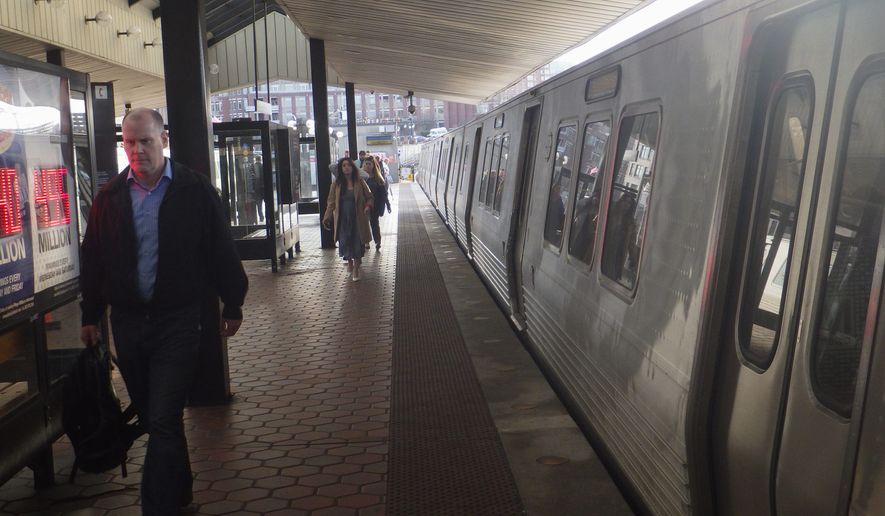Commuters around Alexandria are grumbling, as Metro prepares to shut down the subway south of Ronald Reagan Washington National Airport for long overdue maintenance this summer.
Subway rider John Ramos said he has endured several delays over many months because Metro has single-tracked trains in its ongoing maintenance and repair program.
“I’m undecided how I feel, but I’m open to it and I understand work is necessary for long-term relief,” Mr. Ramos said. “I’m a patient man — but not endlessly.”
“I know all kinds of changes are going on with the Metro, but I’m just dissatisfied with the Metro’s lousy service, and I just hope we live to see the pendulum swing the other way,” another commuter said.
Metro has announced plans to shut down the Yellow and Blue Lines south of Reagan National from May 25 through Sept. 2 to repair and rebuild platforms at six stations. Four of those stations — Van Dorn, Eisenhower Avenue, King Street, and Braddock Road — are in Alexandria. The other two — Franconia/Springfield and Huntington — service the city via bus routes.
The Washington Times recently conducted an informal survey of 100 respondents during their weekday commute along the Blue and Yellow Lines in the affected areas. Of the 100 respondents, 38 said they were hearing the news for the first time. Of those who provided an opinion, 53 said they were dissatisfied with the development, nine approved of it and 30 said they were neutral.
Yon Lambert, director of Alexandria’s Department of Transportation and Planning, said his agency has been working with Metro to augment existing bus service, provide shuttle buses and notify riders of transit alternatives. On a typical weekday, Metro serves about 27,000 Blue and Yellow Line riders south of the airport.
In response to worries about increased traffic, Mr. Lambert said the Alexandria’s SmartMobility program, which monitors traffic signals throughout the city, will help ease congestion. Also, city’s police department will be involved in directing traffic, with the expedient movement of the shuttle buses a top priority.
Alexandria also will add 12 buses and extra staffers to its DASH fleet, and hasn’t ruled out the possibility of adding more.
“DASH sees this as an opportunity for them to remind the public that they move around 12,000 people around the city on a normal day,” Mr. Lambert said. “This is an opportunity for them to show people how easy it is to get around the city using DASH buses, and why DASH is such a great alternative.”
Still, Alexandria faces the prospect of lost tourism revenue during the subway shutdown. Visit Alexandria, the organization managing the city’s tourism initiative, commissioned a study that forecast a 10 percent to 15 percent loss in tourism revenue during the affected period, with a full recovery in September.
Mr. Lambert said Metro officials considered the shutdown’s impact on tourism but decided to do the maintenance in summer because that’s when commuter ridership is lowest.
To counter the expected revenue loss, Visit Alexandria has created a “Love Your Summer in Alexandria” package for hotel guests who stay two nights or more in the city. The organization also has handed out flyers about alternatives such as the Potomac Riverboat Co.’s water taxis, bike share and Virginia Railway Express.
“We know that other communities around the country have experienced similar economic disruptions, often caused by natural disasters or public safety events. In this case, because the disruption is known in advance, we are better able to anticipate and mitigate it,” said Tom Kaiden, chief operating officer of Visit Alexandria.
This summer’s maintenance is part of Metro’s Platform Improvement Project to repair 20 platforms over the next two years as part of the $15.5 billion Capital Improvement Program.
According to Metro, the shutdown will compress the construction schedule by 94 percent. Additionally, Metro and its partners are touting the benefits in safety and efficiency in ’round-the-clock construction.
“Metro is doing that in part for the safety of riders. It is important to note that if this construction went on for months or even years, we’re introducing ongoing construction at their stations. We think it’s a good thing they’re getting this work done faster,” Mr. Lambert said.




Please read our comment policy before commenting.